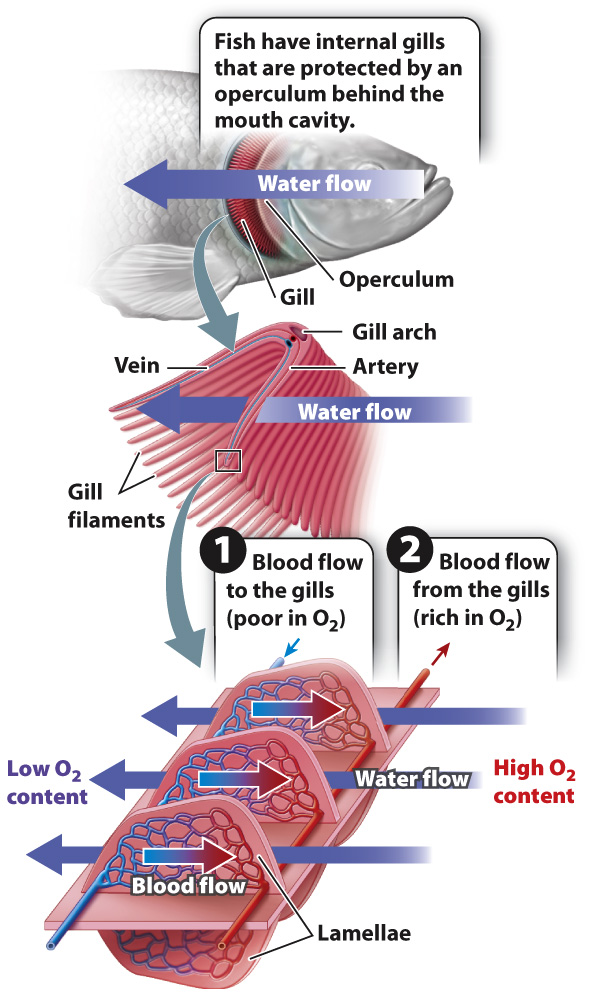Many aquatic animals breathe through gills.

Most large aquatic animals (with the notable exception of marine mammals like dolphins and whales) breathe O2-containing water through gills. Some sessile invertebrates have external gills; these organisms include tube worms and sea urchins, as well as nudibranch mollusks and aquatic amphibians (see Fig. 39.4a). However, because external gills are easily damaged or may be eaten by predators, most mollusks, crustaceans, and fishes have evolved internal gills that, although still formed as outfoldings of the body surface, are contained within protective cavities. Whereas the external gills of invertebrates often rely on the natural motions of the water to move water past the gills, invertebrates with internal gills often have cilia that direct water over the gill’s surface.
Fish need sufficient O2 to meet the energy demands of swimming. As a result, they actively pump water through their mouth and over the gills, which are located in a chamber behind the mouth cavity (Fig. 39.5). The effort required to ventilate the gills could be high because of the density and viscosity of water, but fish greatly reduce the energy cost of moving water by maintaining a continuous, unidirectional flow of water past their gills. In bony fishes, a protective flap overlying the gills, called the operculum, expands laterally to draw water over the gills while the mouth is refilling before its next pumping cycle.
The gills of fish typically consist of a series of gill arches located on either side of the animal behind the mouth cavity and, in bony fishes, beneath the operculum. Each gill arch consists of two stacked rows of flat leaf-

The lamellae are oriented so that the blood flowing through them in a capillary network moves in a direction opposite to the flow of water past the gills (Fig. 39.5). This type of organization, in which fluids with different properties move in opposite directions, is an efficient way to exchange properties between the two fluids. The property can be a chemical property, such as O2 concentration, or a physical property, such as heat. The movement of two fluids with different properties in opposite directions is called countercurrent flow.
Consider for a moment two tubes right next to each other, one carrying hot water and the other carrying cold water (Fig. 39.6). If we want to make the hot water cold and the cold water hot, the efficiency of heat transfer between the two tubes depends on the direction of flow. When the water in the tubes flows in the same direction (concurrent flow), the hot water gets colder and the cold water gets hotter since heat is transferred between the two tubes (Fig. 39.6a). Given enough distance, the water will be at an intermediate (warm) temperature at the end of the tubes, reaching the same average temperature in both tubes.
Now consider what happens when the water in the two tubes flows in opposite directions (countercurrent flow). In this case, the cold water encounters increasingly hot temperatures and, given enough distance, becomes nearly as hot as the hot water entering the other tube (Fig. 39.6b). Similarly, the hot water encounters increasingly cold temperatures, and becomes nearly as cold as the cold water entering the other tube. With countercurrent flow, the two essentially exchange properties (heat, in this example).
This mechanism, known as countercurrent exchange, is used widely in nature. As a result of countercurrent exchange, fish gills can extract nearly all the O2 in the water that passes over them (Fig. 39.6c). The O2 in the oxygen-